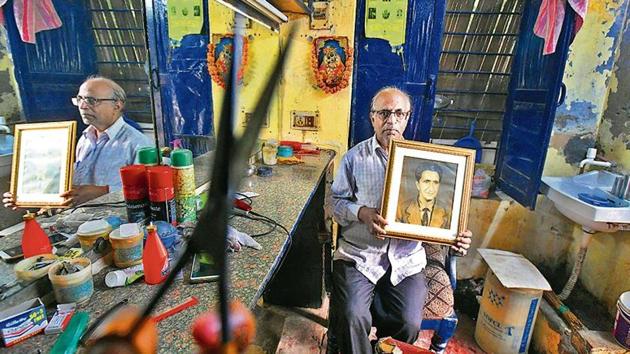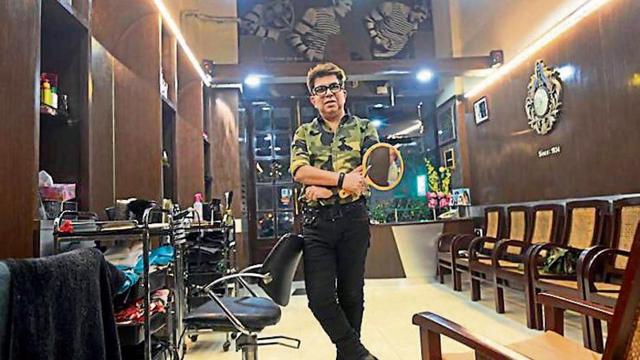Local salons in Delhi snip competition to size
As Delhi government announces a ‘Kesh Kala Board’ for barbers, HT visits local salons to see how they are countering competition from their bigger counterparts.
Mushtaq Ahmad, 65, is clipping the hair of a client in his small salon, his scissors moving deftly, making a snipping sound. After a while, he stops and asks his client to have a look at his hair in the mirror in front of him. Pawan Gupta, the client, a local businessman, seems pretty satisfied as he examines his hair in the mirror.

“ Mushtaq is an artist, no other barber could have pulled it off; my hair is thin and I have bald patches, which he has covered by giving me a unique haircut,” says Chopra, who describes Mushtaq as a ‘close friend’, who knows not just his hair but also everything about his life. I have been coming to his salon for over four decades; he was the one who gave me a haircut for my wedding 42 years ago.”
Ahmad runs Romeo Hair Beauty Stylist, a hair salon in north Delhi’s Kamala Nagar, and before anything else, Mushtaq tells you the ‘Romeo’ in the shop’s name defines his work, not him . “When I started the salon, one of my customers felt that I cut hair with a lot of love and dedication, so he decided to name it Romeo,” says a soft-spoken Ahmad, one of the better-known barbers in north Delhi. “Hairstyling is an art, and it needs more appreciation than it has got so far in the country. I have heard the government is coming up with a scheme to support and train barbers in the city,” Mushtaq says.
The ‘scheme’ he is referring to is a recent announcement by the Delhi Government that it would set up a ‘Kesh Kala Board ‘to revive and promote the traditional art of hair grooming by implementing welfare measures for barbers and providing them with advanced training and financial assistance’. “The barber community needs to be provided with adequate training on the latest technology prevailing in the industry and they even require financial assistance for self employability,” the government said .
Men’s hair salons in Delhi, as elsewhere in the country, have been a sort of local institutions, attracting not just those wanting a quick, affordable haircut and shave; but many others who come to catch up on local gossip, watch movies on the portable TVs often perched on iron frames, and to read newspapers. Some of these family-run neighbourhood salons such as SR Gaur Hair Dressers in Connaught Place have been around since the early 1930s, and kept with times. Others, failing to adopt new technology and techniques, have lost a large chunk of their clientele to the new fancy chain salons.
“Until 15 years ago, our salon had both rich and middle-class customers. Those days you either you went to a salon at a five-star hotel or your neighbourhood salon. Now there are so many options. A lot of our clients have drifted to these fancy chain salons, which provide them good experience and ambiance, well-groomed barbers, and probably better haircuts, too,” says Mohmmed Hanif, 35, who runs King Salon in the walled city.
Hanif says that while a majority of the independent neighbourhood salons have, over the years, expanded their services offering everything from a haircut, to facials, to massage, to colouring, to hair straightening; they cannot match the range of products and services that the new chain salons offer. “A majority the neighbourhood salons have failed to upgrade their infrastructure, because of lack of funds. Barbers in these salons need training and financial support to keep their art alive,” says Hanif, giving a haircut to a client. “Most men come for a haircut only; for man, his distinct hairstyle is central to his idea of beauty.”
Hanif, who has studied up to class 8, talks like an expert on what he calls ‘social role of salons’. “Unlike a chain salon, a neighbourhood barbershop is a community space. It is a place where an individual forgets his worries; and there is a spring in his steps when he walks out, feeling new, clean and confident. You will not get this feeling in the business-like atmosphere of a chain salon.”
It is Thursday afternoon and one of his clients, a teenager, dressed in a yellow shirt and a pair of black jeans, walks in, wanting a hair cut he has seen on Tik Tok. Unlike in the past, Hanif says, when young people drew inspiration for hairstyles from magazines such as Filmfare, Stardust and Cine Blitz, now they get it from social media platform such as Tik Tok. “They want us to give them the weird haircuts they see on Tik Tok , which they show us on their mobile phones,” says Hanif. No wonder then most of these hair salons have, in the past few years, removed the large posters—once an essential part of their salons interior décor-- depicting different hairstyles for their clients. He charges ₹60 for a haircut, and makes about Rs15,000 a month.

Most independent salons in the city are run by barbers from villages in Bijnor and Amroha in UP. They employ barbers on a commission basis (40% on the total bill) , and they earn about Rs10,000 a month on an average. Most barbers cook, eat and sleep in their salons.
“I am under apprenticeship here and earn ₹6,000 a month, I cannot afford to rent a place. I do not have money to get better training at an academy. The other day a man shouted at me, saying I had cut his hair shorter than he wanted,” says Furquan, 18, who started working as a barber only six months ago at Jawahar Hair Cutting salon in the walled city.
Shankar Bharti, 65, a barber , feels the salon where he works is part of the city ‘heritage and history’. The salon, known as ‘University Hairdresser’ near Gwyer Hall has certainly been a landmark in Delhi University. It was started in 1946 by Deep Chand, who was one of the most celebrated hairdressers in north Delhi, and his clientele included university professors, hostellers, former union minster such as Dr Karan Singh, former Lieutenant Governor of Delhi Vijai Kapoor , among several other well-known figures.
After Deep Chand’s death in 2006, Bharti’s nephews, Rajpal and Jagat Narayan, who like Bharati worked with Deep Chand, took over the salon. “Most of our clients now are poor students from smaller towns. We do not make much money, but want to keep alive the legacy of Deep Chand,” says Bharti, a barber for 50 years. He joined Deep Chand in 1992 and worked with him till his death.
Deep Chand’s famed salon seems to be caught in a time warp. It is pretty much like what it was in the 1940s.
There are two vintage chairs and a small wooden bench. On the walls are framed letters of appreciation, and photographs of Deep Chand with politicians who were his patrons. The shop has razors and scissors from the 1950s. The only sign of modernity is an electric trimmer, which, he says, his nephews use when university students insist.
Talking of his own beginnings as a barber, he says that scissors, ustra (razor) and combs were the only equipment they had. “There were no blades those days. The first thing a barber would do in the morning is sharpen their ustras by rubbing them on a stone. It took time and required skill,” says Bharti, making it clear that he is not trained to use new equipment such as tongs, clippers, and electric trimmers. “I do not need them; I am a barber; not a grooming expert.”
Bharti says, a defeated look in his eyes, that though barbers used to play an important role as messengers, mediators in marriages; their social status has not changed much over the years. “In villages, barbers used to arrange a marriage, did background checks on families,” he says. “Some from our community have opened fancy salons, but they are treated as nothing more than glorified nais (barbers). People’s attitudes have not changed much towards barbers”.
But Mujeeb Rehman, 48, does not agree. In fact, very few hairdressers in the city speak of their profession with the pride that he does. His grandfather started SR Gaur Hair Dressers in Connaught Place in 1934. While over the years, the salon has undergone modernisation in terms of adopting new technology and new techniques, it continues to boast an old-world charm. The ceiling fan, the doors, the chairs for the waiting customers are all from the 1930s.
“Attitudes have certainly changed and now hairdressers are seen as professionals, and salons are opened by the people who do not belong to the barber community. Here at our salon, I do all the haircuts myself. My two brothers are top executives in a German multinational beauty products company; on weekends, when there is a lot of rush, they come and help me with the haircuts. We all are proud of what we do,” says Rehman, who looks pretty dapper in his thick-rimmed glasses, camouflage shirt and a pair of tight-fitting jeans. “A hairdresser should be well-groomed himself and look good to inspire confidence in his clients,” says Rehman, who charges ₹500 for a haircut.
His salon, he says, attracted rajas, maharajas, top businessmen and leaders before Independence. “We still have families whose fourth generation is our customer. I know all my customers personally, and what hairstyle suits them. Unlike us, who have loyal clients, most chain salons have walking clients. The attention we pay to them is what sets us apart from the company-owned salons”.
Stay updated with all top Cities including, Bengaluru, Delhi, Mumbai and more across India. Stay informed on the latest happenings in World News along with Delhi Election 2025 and Delhi Election Result 2025 Live, New Delhi Election Result Live, Kalkaji Election Result Live at Hindustan Times.
Stay updated with all top Cities including, Bengaluru, Delhi, Mumbai and more across India. Stay informed on the latest happenings in World News along with Delhi Election 2025 and Delhi Election Result 2025 Live, New Delhi Election Result Live, Kalkaji Election Result Live at Hindustan Times.






